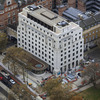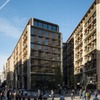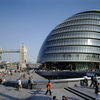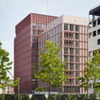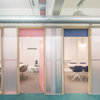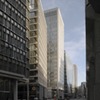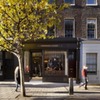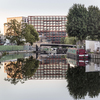US Embassy
Subscribe now to instantly view this image
Subscribe to the Architects’ Journal (AJ) for instant access to the AJ Buildings Library, an online database of nearly 2,000 exemplar buildings in photographs, plans, elevations and details.
Already a subscriber? Sign in
The embassy is part of the regeneration of Nine Elms in London
Richard Bryant Download Original
A single-minded pursuit of environmental performance is a hallmark of the new US Embassy in London.
An innovative cladding of kite-like ETFE units is the new embassy’s most distinctive feature. Conceived at competition stage and originally intended to integrate photovoltaic sensors, the resulting angular hour-glasses are most successful from afar. More conventional brise-soleil and louvres were studied early on but ruled out because of the enormous amount of material required to screen what is essentially a fully-glazed cube. ETFE was chosen for its lightness, transparency and durability and as the most environmentally responsible way to passively shade the building. Rather than a more typical cushion application, here ETFE is deployed as a stretched skin. During design development, the ETFE units were ‘optimised’, pinched at eye level to retain views and detailed to eliminate thermal breaks and stand proud of the building to allow for cleaning and maintenance using conventional equipment.
Inside, the main lobby feature a floor-to-ceiling bas-relief of a house by Rachel Whiteread that greets visitors applying for new passports and visas.
The design includes a reclaimed water system, combined heat and power plant, ground source heat pumps, solar photovoltaic arrays, optimisation of daylighting and occupant control of systems, habitat and public amenity creation. These and other features were leveraged by combining the embassy’s design requirements, alternate design approaches and technology choices for equipment to maximise energy savings for the compound while maintaining the required security levels.
A combination of lower-carbon technologies, such as ground source heat pumps, heat recovery generators and heat recovery heat pumps was used to meet the building’s energy load requirements with cleaner energy means. The design was supplemented with green technologies such as the solar arrays on the roofs of the chancery and pavilions.
The embassy building’s envelope is triple-glazed, with two low-e coatings, blast-resistant, and thermally broken. The inner envelope is the building enclosure, while the outer envelope is a multi-functional environmental filter.
Data
- Begun: Nov 2013
- Completed: Jan 2018
- Floor area: 48,128m2
- Sectors: Civic, Office
- Total cost: £720M
- Address: 33 Nine Elms Ln, London, SW8 5DB, United Kingdom
Professional Team 
- Architect: KieranTimberlake Associates
- Project architects: James Timberlake, Richard Maimon
- Client: US Embassy
Suppliers
- Structural and physical security engineer: Thornton Tomasetti
- MEP, civil, facade and sustainability engineer: Arup
- Cost estimator: AECOM
- US lead contractor: BL Harbert International
- UK lead subcontractor: Sir Robert McAlpine
- CAD software used: Autodesk Revit















